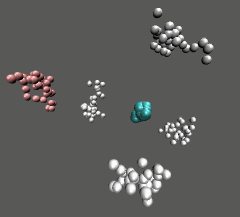It is critically important for many applications in chemistry to develop methods for accurate calculations of chemical reaction rates. For reactions occurring at sufficiently high temperatures and involving heavy atoms, classical molecular dynamics can be used to obtain accurate rate constants. At low temperatures, particularly for reactions involving the motion of light atoms, classical dynamics methods fail since quantum mechanical (QM) effects (such as zero point energy, tunneling and quantum coherence) become critically important. However, it is still impossible to solve the quantum reactive scattering problem for more than a few atoms. During the last two decades, a number of approximate quantum mechanical methods, which avoid the complications of the fully quantum mechanical formulation, have been proposed. One of such approximate methods - the ring polymer molecular dynamics (RPMD) rate theory - was recently developed at Oxford University and proposed by us as an efficient alternative to transition-state theory methods. It has been shown that the well-known isomorphism between the quantum statistical mechanics of distinguishable particles and the classical statistical mechanics of harmonic ring polymers can be used as an approximation to the exact quantum dynamics of the system. The resulting ring polymer molecular dynamics (RPMD) method has been applied to a number of simple systems.

We developed an efficient implementation of the ring polymer molecular dynamics (RPMD) method for calculating bimolecular chemical reaction rates, and illustrated it with applications to some benchmark chemical reactions. We also showed that this methodology can be used for more complex polyatomic reactions in their full dimensionality, such as hydrogen abstraction reaction from methane, H + CH4→H2 + CH3, or from ethane, H + C2H6→H2 + C2H5. The results of our work confirm that RPMDrate is the most accurate and reliable code for evaluating thermal rate constants for complex chemical reactions which can be used in a wide range of temperatures.
RPMD rate coefficient is ...
Simple and fast to compute:
- RPMD is classical molecular dynamics in an extended phase space;
- computation time is proportional to the number of beads (Nb);
- convergence with respect to Nb is rapid, suggesting wide applicability for many reactions involving polyatomic molecules.
Independent of the choice of the transition state dividing surface s(q):
- a feature that is not shared by any transition-state theory method for which the proper choice of s(q) becomes more of an issue as the dimensionality of the reaction increases.
More accurate than all other approximate quantum mechanical rates:
- exact in the high-temperature limit;
- reliable at intermediate temperatures;
- captures perfectly the zero-point energy effect;
- more accurate than other methods in the deep quantum tunneling regime, within a factor of 2-3 of the exact QM results;
- also provides accurate estimates for reactions of barrierless type.
Provides systematic and consistent performance:
- Overestimates thermal rates for asymmetric reactions and underestimates them for symmetric reactions in the deep tunneling regime.
(Note: the zero-point energy effect along the reaction coordinate must be taken into account when assigning the reaction symmetry.)
RPMDrate is a free, open-source software package for using ring polymer molecular dynamics (RPMD) simulations to compute the bimolecular reaction rate coefficients.
Parts of the documentation:
RPMDrate User's Guide
Publications
Download
Contact